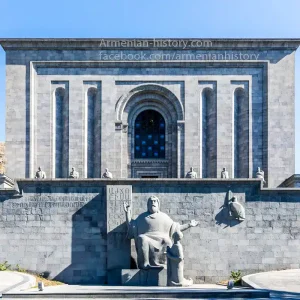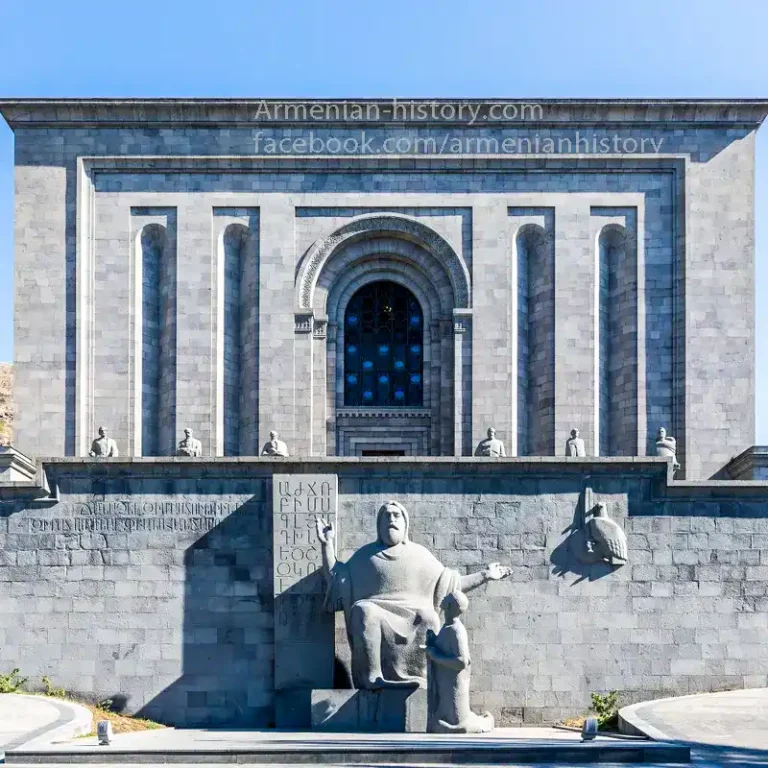Few figures in Armenian history carry the depth of reverence and cultural weight as Mesrop Mashtots. Born in the 4th century, he wasn’t just the inventor of the Armenian alphabet—he was the visionary who safeguarded a people’s soul through language. His creation of the alphabet was not a mere linguistic innovation but an act of spiritual and cultural resilience that enabled Armenians to preserve their faith, traditions, and national consciousness amid turbulent centuries of foreign domination.
Origins and Education
Mashtots was born around 360 AD in the province of Taron, then a part of Greater Armenia, into a family of noble yet modest means. His early life unfolded during a time of immense transformation: Armenia had adopted Christianity as a state religion in 301 AD, yet its cultural infrastructure lagged behind its religious shift. Young Mashtots, known for his intellectual vigor and spiritual clarity, received a deep education in languages—Armenian, Greek, Syriac, and Persian. These languages were more than scholarly tools; they were the keys to empire, scripture, and diplomacy.
Mashtots initially served as a scribe and military official at the court of King Khosrov IV. However, his growing discomfort with court life led him to leave behind prestige and security in pursuit of a spiritual calling. He became a monk and dedicated himself to preaching the Christian Gospel across Armenian-speaking communities.
The Crisis of Language and Identity
By the early 5th century, the lack of a native Armenian script was a dire concern. Religious texts were in Greek and Syriac, inaccessible to the general population. The clergy, while committed, were limited in their capacity to spread doctrine in the vernacular. Mashtots understood the danger of cultural and spiritual erosion. If Armenians were to survive as a distinct Christian nation under the looming pressures of Byzantium and Persia, they needed a script of their own—one capable of capturing the nuances of their language and expressing the truths of their faith.
With the blessing of Catholicos Sahak Partev and the political support of King Vramshapuh, Mashtots embarked on a journey to solve this existential dilemma. Historical sources—including his student Koryun—suggest that Mashtots traveled to places like Edessa and possibly Samosata to study existing scripts and consult with Christian scholars. His quest was as much theological as it was linguistic.
Invention of the Armenian Alphabet
In or around 405 AD, Mashtots unveiled the Armenian alphabet: 36 original letters, each representing a unique sound in the Armenian language. The script’s elegance and precision testified to its creator’s deep understanding of both linguistics and phonology. It was a moment of profound significance—an act that stitched Armenia’s spiritual mission with its cultural survival.

The first text translated using the new alphabet was the Bible, beginning with Proverbs 1:2: “To know wisdom and instruction; to perceive the words of understanding.” The choice was no coincidence. It reflected Mashtots’ belief in divine knowledge as the foundation of both personal and national transformation.
Cultural Renaissance and Educational Reform
The impact of the alphabet’s creation was immediate and immense. Mashtots didn’t stop at invention—he founded schools across Armenia where young clerics and scholars learned the new script, theology, and philosophy. These schools weren’t just religious seminaries; they were cultural strongholds that produced many of the Golden Age figures of Armenian literature, including Movses Khorenatsi, Eznik of Kolb, and Ghevond.
The Armenian Golden Age of literature flourished thanks to Mashtots. Works of theology, philosophy, grammar, and history were either written anew or translated into Armenian. Oral traditions—myths, folk tales, genealogies—were written down, giving future generations access to Armenia’s collective memory.
Missionary Work Beyond Armenia
Mashtots’ achievements did not end at Armenia’s borders. His expertise in linguistics and theology led him to assist in the development of scripts for neighboring regions. He is credited with influencing the creation of the Georgian and Caucasian Albanian alphabets, recognizing that the path to spiritual sovereignty for other Christian nations required the same tools of literacy and scripture.
Philosophy and Faith
Mashtots was more than an educator—he was a philosopher deeply engaged with the moral and metaphysical dimensions of life. He saw language not just as a practical necessity but as a divine gift, a medium through which truth could be understood, debated, and internalized. His belief in the transformative power of literacy was radical for its time. He viewed education as a sacred duty, a form of worship, and an act of defiance against oppression.
His theological contributions also shaped the Armenian Apostolic Church’s doctrinal foundations. Mashtots helped guide the Church through turbulent ecumenical debates, resisting pressures to conform to either Byzantine or Persian theological positions, and instead cultivating a uniquely Armenian interpretation of Christian orthodoxy.
Later Years and Death
Mashtots spent his final years continuing to teach and write. He died in 440 AD and was buried in the village of Oshakan, in the Aragatsotn region of Armenia. Today, the Saint Mesrop Mashtots Church stands above his tomb, drawing thousands of visitors and pilgrims each year.
Legacy
Mashtots’ legacy is immortal. His invention gave Armenians a vessel to carry their voice through centuries of war, exile, and genocide. The Armenian alphabet is more than a linguistic system—it is a spiritual monument, etched into manuscripts, carved into khachkars, and etched into the identity of every Armenian child who learns to write their name.
The Matenadaran, Armenia’s repository of ancient manuscripts in Yerevan, is officially named the Mesrop Mashtots Institute of Ancient Manuscripts. There, thousands of handwritten texts bear witness to the enduring life of his alphabet.
Commemoration and Honors
Mashtots was canonized by the Armenian Church and is celebrated every year on February 19. He is commemorated not only in religious observance but also in Armenia’s public life—through statues, schools, and even currency. His name is synonymous with enlightenment, nationhood, and enduring faith.
To understand Mesrop Mashtots is to understand the spirit of the Armenian people. His invention was not merely an academic triumph—it was a nation’s answer to cultural erasure. In the face of empires that sought to assimilate or annihilate, Mashtots gave Armenians the ability to speak, to teach, to pray, and to remember in their own voice. His alphabet didn’t just teach a people to read; it taught them to endure.

